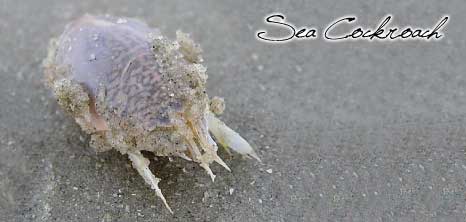|
Sea CockroachesWithin the sandy beaches on the island of Barbados, it doesn't seem as if there would be much scope for life. However, there is one creature that doesn't mind having to constantly tolerate the changing tides and possible predators and that creature is the Sea Cockroach.
What we readily refer to here on the island of Barbados as Sea Cockroaches (Hippa cubensis), are a kind of crab, commonly referred to elsewhere as mole or sand crabs.
Just How They Do ItThese creatures with their rippled sand coloured bodies can be seen washing in and out with the tide and sometimes becoming stranded on the beach. Conditions on the beach have to be just right with enough water available to separate the grains of sand to make them porous as they are unable to dig in sand that is too dry or compacted.
On the onset of incoming waves, Sea Cockroaches will use their legs to burrow backwards into the sand. They are equipped with small first antennaes that project from the sand and function in the same way snorkels function for breathing. When the waves recede, they large feathery antennaes are curled backwards and used as nets to take possession of phytoplankton. These plankton consist of microscopic plants that are now scraped away from the antennaes by other specialised, brush-like appendages. These creatures, whose semblances are very close to the sand on the shores of Barbados, are herbivores that take the opportunity to feed on dinoflagellates and diatoms when the waves recede.
When on the beach in Barbados, look out for small bubbles emerging from small holes in the sand. As the waves wash ashore, sea cockroaches can be seen scurrying around to catch the next surf so that they can bury themselves before the water disappears again.
The people of Barbados are well aware of the fact that these Sea Cockroaches are unable to bite and as such, can be seen playfully picking them up and tossing them back onto the sand.
|



